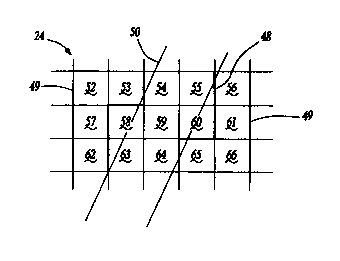Some of the information on this Web page has been provided by external sources. The Government of Canada is not responsible for the accuracy, reliability or currency of the information supplied by external sources. Users wishing to rely upon this information should consult directly with the source of the information. Content provided by external sources is not subject to official languages, privacy and accessibility requirements.
Any discrepancies in the text and image of the Claims and Abstract are due to differing posting times. Text of the Claims and Abstract are posted:
| (12) Patent Application: | (11) CA 2330783 |
|---|---|
| (54) English Title: | NAVIGATION SYSTEM WITH ANTI-ALIAS MAP DISPLAY |
| (54) French Title: | SYSTEME D NAVIGATION AVEC TRAITEMENT ANTICRENELAGE DES CARTES |
| Status: | Deemed Abandoned and Beyond the Period of Reinstatement - Pending Response to Notice of Disregarded Communication |
| (51) International Patent Classification (IPC): |
|
|---|---|
| (72) Inventors : |
|
| (73) Owners : |
|
| (71) Applicants : |
|
| (74) Agent: | GOWLING WLG (CANADA) LLP |
| (74) Associate agent: | |
| (45) Issued: | |
| (86) PCT Filing Date: | 1999-04-16 |
| (87) Open to Public Inspection: | 1999-11-11 |
| Availability of licence: | N/A |
| Dedicated to the Public: | N/A |
| (25) Language of filing: | English |
| Patent Cooperation Treaty (PCT): | Yes |
|---|---|
| (86) PCT Filing Number: | PCT/US1999/008462 |
| (87) International Publication Number: | WO 1999057518 |
| (85) National Entry: | 2000-11-01 |
| (30) Application Priority Data: | |||||||||
|---|---|---|---|---|---|---|---|---|---|
|
A nivigation system includes a display displaying a map of roads from a road
database. The navigation system utilizes a palette of colors to display the
road and background on the display. The palette preferably includes a
plurality of shades for each of a plurality of colors to be displayed
including the background color and the road color. The roads on the display
are preferably anti-aliased by indexing a different intensity of the shade of
the object based upon the relative position of the pixel and an ideal object
area.
La présente invention concerne un système de navigation comprenant un affichage de cartes routières à partir d'une base de données cartographiques. Ce système de navigation fait appel à une palette de couleurs pour les routes et le fond. Cette palette renferme de préférence une pluralité de teintes pour chaque pluralité de couleurs d'affichage, y compris pour le fond et les routes. Les routes affichées sont soumises de préférence à un procédé d'anticrénelage qui consiste à indexer une intensité différente pour le ton de l'objet en fonction de la position relative du pixel et d'une zone d'objet idéale.
Note: Claims are shown in the official language in which they were submitted.
Note: Descriptions are shown in the official language in which they were submitted.

2024-08-01:As part of the Next Generation Patents (NGP) transition, the Canadian Patents Database (CPD) now contains a more detailed Event History, which replicates the Event Log of our new back-office solution.
Please note that "Inactive:" events refers to events no longer in use in our new back-office solution.
For a clearer understanding of the status of the application/patent presented on this page, the site Disclaimer , as well as the definitions for Patent , Event History , Maintenance Fee and Payment History should be consulted.
| Description | Date |
|---|---|
| Inactive: IPC from MCD | 2006-03-12 |
| Application Not Reinstated by Deadline | 2003-04-16 |
| Time Limit for Reversal Expired | 2003-04-16 |
| Deemed Abandoned - Failure to Respond to Maintenance Fee Notice | 2002-04-16 |
| Letter Sent | 2001-04-06 |
| Inactive: Single transfer | 2001-03-08 |
| Inactive: Cover page published | 2001-02-27 |
| Inactive: First IPC assigned | 2001-02-25 |
| Inactive: Courtesy letter - Evidence | 2001-02-20 |
| Inactive: Notice - National entry - No RFE | 2001-02-14 |
| Application Received - PCT | 2001-02-12 |
| Application Published (Open to Public Inspection) | 1999-11-11 |
| Abandonment Date | Reason | Reinstatement Date |
|---|---|---|
| 2002-04-16 |
The last payment was received on 2001-04-17
Note : If the full payment has not been received on or before the date indicated, a further fee may be required which may be one of the following
Please refer to the CIPO Patent Fees web page to see all current fee amounts.
| Fee Type | Anniversary Year | Due Date | Paid Date |
|---|---|---|---|
| Registration of a document | 2000-11-01 | ||
| Basic national fee - standard | 2000-11-01 | ||
| MF (application, 2nd anniv.) - standard | 02 | 2001-04-17 | 2001-04-17 |
Note: Records showing the ownership history in alphabetical order.
| Current Owners on Record |
|---|
| MAGELLAN DIS, INC. |
| Past Owners on Record |
|---|
| ANTHONY ALBERT SLOMINSKI |
| JEFFREY ALAN MILLINGTON |